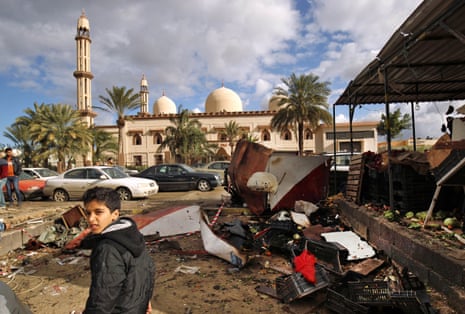Civilians killed or injured in Libya by explosive weapons rose by 131% last year, with the number of incidents at its highest since 2011, the year of the Benghazi uprising, according to new data seen by the Guardian.
Most of the 900 people who died or were hurt in explosions in the country in 2019 – up from 392 in 2018 – were victims of airstrikes, according to statistics from Action on Armed Violence (AOAV), a charity based in London.
Libya was one of several countries to buck the downward global trend in civilian casualties from explosive weapons.
The worst places for civilian killings and maimings were Libya, Afghanistan and Somalia, but increases were also recorded in Sri Lanka, India, Philippines, Turkey, Gaza, Egypt, Colombia, and Myanmar.
While Syria remained the country worst impacted by explosive weaponry in 2019, casualties decreased by about a quarter: 7,268 compared to the previous year, at 9,587.
AOAV recorded 29,499 deaths and injuries by explosive weapons in 2019, 66% of which (19,407) were innocent civilians. When explosive weapons were used in populated areas, 91% of those killed were civilians, compared to 15% of civilians in other areas.
The group’s executive director Iain Overton said: “While the general shift is towards a reduction in explosive harm globally, some countries are seeing concerning increases in violence. As 2020 shows a real potential for renewed war in the Middle East, 2019 reminds us how fragile peace can be.”
At least 28 people died in an attack on a military academy in the Libyan capital of Tripoli in the first weekend of 2020 and there are fears fighting will escalate further in Libya with Turkey’s parliament voting to send in troops in support of the internationally recognised Government of National Accord, which is facing an offensive by Khalifa Haftar’s Libyan National Army.
Overton, author of The Price of Paradise: how the suicide bomber shaped the modern age, predicted an uptick in Shia suicide bombings this year. There were 133 suicide attacks last year, one every three days, he said, largely by Salafist groups. Overall, IEDs account for 49% of civilian harm.
“There is a constant and this constant shows us that our data is pretty robust,” said Overton. “That’s why we are asking for a political commitment through the UN member states to sign up to a declaration to prevent the use of explosive weapons in populated areas.”
In October, Amnesty International reported scores of civilian casualties in Libya as “both sides use everything from Gaddafi-era unguided rockets to modern drone-launched guided missiles in attacks that could amount to war crimes”.
Airstrikes accounted for 72% of civilian casualties in Libya in 2019 and shelling, 19%, AOAV said. Despite the rising number of incidents, 125 in 2019, compared to 134 in 2011, the death toll in 2019 is far lower than in 2011, when 2,108 civilians died.
Donatella Rovera, crisis response adviser at Amnesty International who worked on the report, said: “We are seeing fewer casualties compared to other conflicts in the region, of course every one civilian casualty is one too many.”
She said, however, in Libya, it was difficult to accurately interrogate data. For instance, one of the biggest attacks reported on civilians was on the migrant detention centre in July, when between 40 and 50 people were reportedly killed.
“The reality is we have not found evidence to substantiate the numbers. The only thing we saw was a handful of body bags in an image,” she said.
Somalia also saw a 14% rise in civilian harm from explosives, mostly improvised explosive devices, from 832 in 2018 to 945 in 2019, while Afghanistan, which has seen record numbers of civilian casualties over the last four years, continued on its violent trajectory upwards.
Unlike in 2018, when the surge in Afghan violence was attributed to an increasing Isis presence, last year saw a “notable” increase in Taliban violence. There was a 9% rise in the killing and maiming of civilians from explosives, from 4,268 to 4,638 in 2019. AOAV recorded a 187% increase in civilian casualties from Taliban use of explosive weapons, to 1,896 this year.
UN member states are currently taking part in a political process run by the Irish government to adopt stronger rules in urban areas, including halting the use of certain weapons.
Laura Boillot, co-ordinator of the International Network of Explosive Weapons (Inew), said: “We have been looking at the data AOAV has been producing for 10 years. We’ve seen a consistent pattern of harm, because conflict is increasingly in populated areas.”
“Aircraft bombs are inaccurate. Even precision weapons can be problematic as they have a level of explosives in them. Rocket systems are problematic because they can be inaccurate. Even if you are aiming for a military target, you might hit a block of flats or a hospital. These weapon systems have no place in towns and cities.”
Inew is calling on member states to sign up to a political declaration to reduce the use of heavy explosive weapons such as long range artillery and barrel bombs in towns and cities.
The AOAV report was compiled using data from sources including Airwars, the Syrian Observatory for Human Rights and reliable media sources.
